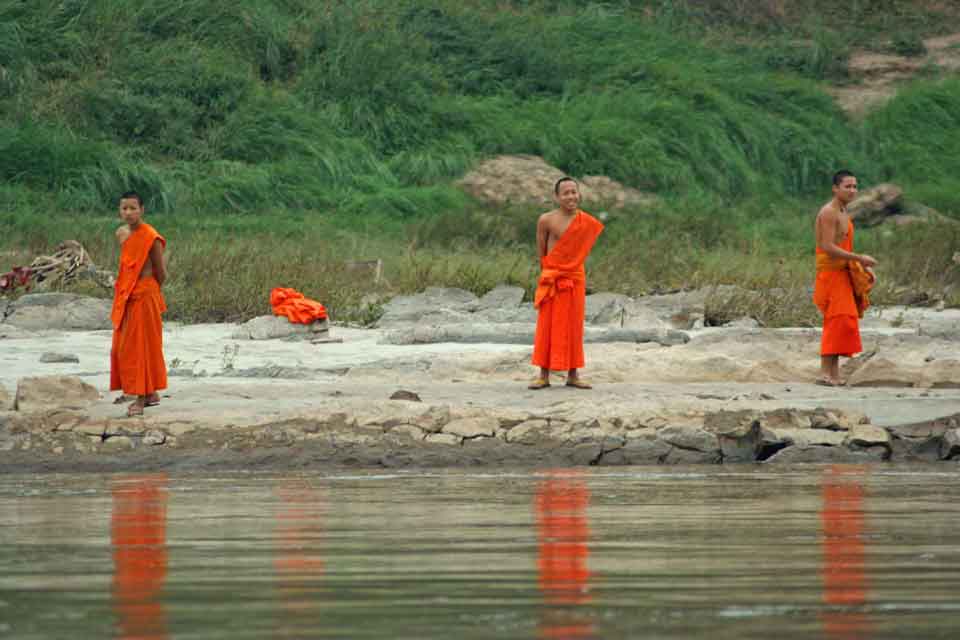Spiritual, colonial and colourful Luang Prabang - the former Royal Capital city of Laos - lulls the visitor into a state of enchantment with its eclectic fusion of cultures, history and traditions.
World Heritage
Our destination after arriving at Vientiane airport was the charismatic city of Luang Prabang - a breath of fresh air after the cacophony of Bangkok.
Built on a peninsula formed by the Mekong - the longest river in Southeast Asia - the UNESCO World Heritage Site is a compelling destination.
Every morning as the stunning sun heralds a new day. Buddist monks in vibrant saffron robes are looked after by local people who keep them sustained with alms (food and snacks) in a ceremony dating back six centuries.
Compelling Caves
 Mesmerising: Buddha statues in Pak Ou Caves.
Mesmerising: Buddha statues in Pak Ou Caves.
One of the many highlights was a trip in a traditional longboat down the Mekong to the historical, spiritual and mysterious Pak Ou Caves situated on an imposing limestone cliff.
The jaw-dropping sight of thousands of Buddha statues of varying heights and depicting wide-ranging positions - meditation, peace and nirvana - prompted an intake of breath.
Most of the stunning wooden statues prayed with lacquer and adorned with gold leaves are said to have been left in the caves by local people.
 Window on Mekong: view from the caves.
Window on Mekong: view from the caves.
Tradition cites ancient kings frequenting the caves on the important occasion of water festival, known as Pimay, to perform a ritual called bathing Buddha.
Taking place on Buddha’s birthday (May 19), the purifying re-enactment symbolises the heavenly dragons showering the Buddha's body with fragrant rain to wash away greed and bestow more wisdom and compassion.
 Traditions: trips take visitors to local villages.
Traditions: trips take visitors to local villages.
The boat trip also includes fascinating visits to local villages along the Mekong where you can barter for the vibrant textiles along with bags, toys and fruit. Doe-eyed children beseeched us to buy birds as souvenirs during this fascinating insight into traditional lifestyles, culture, and customs.
 Cultural insights: children selling birds.
Cultural insights: children selling birds.
Historic Importance
Luang Prabang’s diversity as a UNESCO site spans former royal palaces, temples, traditional urban architecture and French colonial architecture. The latter emanates from the French colonial period starting in 1893 when French forces marched into Laos - until 1953. The distinctive style is still reflected in most major towns and cities in Laos.
A must is Wat Xieng Thong which means ‘Temple of the Golden City’. Highly acclaimed as a shrine in which Lao kings were crowned, the spectacular sight is steeped in a wealth of history.
 Opulent and richly decorated: Wat Xieng Thong.
Opulent and richly decorated: Wat Xieng Thong.
We savoured exploring the opulence of the temple. Built in 1559 on the banks of the Mekong river by King Setthathirath, one of the great leaders in Lao history, it is steeped in the city’s roots of religion, royalty and traditional art.
One of the biggest temples in Luang Prabang which still remains in its original form, exquisite features include elaborate mosaic patterns, wall carvings, rare Buddhist deities and a 12-metre-tall funeral carriage which contains urns for the royal family.
 The funeral carriage where former kings are buried.
The funeral carriage where former kings are buried.
The last King to be buried here was King Sisavangvong who died in 1959. Sixteen years later (1975) brought the demise of the monarchy when the last king, Savang Vatthana, surrendered the throne to Pathet Lao, a left wing nationalist group. The group set up a Marxist state called the Lao People's Democratic Republic, which has controlled Laos ever since.
Captivating Culture
The only landlocked country in South East Asia, the main religion of Laos is Theravada Buddhism which is practiced by 66 per cent of its 7 million people - half of which are monks.
 Buddist monks are a signature of Luang Prabang.
Buddist monks are a signature of Luang Prabang.
A great evening activity in Luang Prabang is exploring the Night Market when traders emerge from their local hill tribes to tempt tourists with blankets, clothes, ceramics, lamps, bed covers, handicrafts and silk scarves.
Pulsating with energy, it’s a great place to sample the local street food which tempted our taste buds. The basic menu includes noodle soup, pho, meat-filled baguettes and grilled meat. We sat on a long wooden table and relished delicious noodles while giving our aching feet a break.
The sensory feast of Luang Prabang would not be complete without the sensational sunsets over the atmospheric Mekong.

Watching the sun sink as dusk emerges, the experience encapsulates the spirituality and rich tapestry of a city which richly deserves to be the Jewel in Laos’ Crown.
Key Facts
Please check government advice on travel
Airlines flying directly to Laos include Qatar Airways, KLM, Singapore Airlines, SilkAir, Sichuan Airlines, Cathay Pacific, Bangkok Airways and Scoot.























